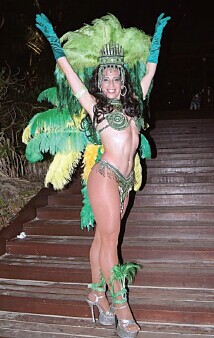 |
|
Santos shows o some classic Brazilian peacocking in this archetypal Carnival costume.[Photo provided to Shanghai Star] |
|
 |
Samba’s dance rhythms, which move side to side as opposed to the front-back movements of jazz, are inspired by former African slave communities, while the colorful headdresses seem to evoke the animals, birds and native tribes of the Amazon.
“It’s more about expressing yourself, feeling the music and interacting with the crowd. You need to feel the song and beat. Just following the steps isn’t enough,” says dancer Maria Santos.
“It’s sexier than salsa and harder to learn, and you’re usually dancing solo rather than doing a duet.
“There’s definitely a stigma about samba being very sensual that makes some people wary of it.”
Bossa nova, a fusion of samba and jazz that became popular in the early 1960s, is perhaps Brazil’s best-known musical export.
The few Brazilian expats like Santos who make their living performing at clubs like Mural or restaurants such as Latina find themselves either bonded by strong friendships or riven by internecine fighting as they vie for lucrative commercial jobs.
“Now they’re all looking for authentic Brazilian dancers, whereas before they would use any foreign face. They’d take a Russian with blonde hair and slap a headdress on her and say ‘this is samba’,” says professional samba dancer and longtime China expat Santos.
The Recife native, who hails from Northeast Brazil, has never been so busy. When we met one recent weeknight during her evening shift at Latina in Xujiahui, where Santos works as a publicity officer and waitress, she had already been going through her moves since 10 am.
After spending five hours rehearsing for a two-month show she’s about to stage at a water park in a neighboring province, she devoted another two hours to practicing Capoeira, the Brazilian martial art that combines elements of dance, music, spinning kicks and gymnastics.
She says countries like South Korea have already embraced similar Brazilian folk customs like boi bumba (literally “beat the bull”), but not in China, yet. “China is just starting to discover about Brazilian culture now,” says Santos.
|
|
|
|
|
|
|
|
